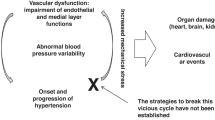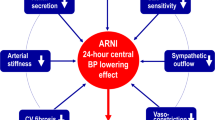Abstract
The endothelium is a favourite early target of cardiovascular risk factors and cardiovascular diseases like hypertension. This key role of the endothelium results from its capacity to respond to numerous autocrine and paracrine stimuli and to mechanical factors like shear stress but also from the pathophysiological consequences of endothelial dysfunction on vasomotor tone, arterial stiffness, arterial remodelling, and inflammation, all of which are factors that play a critical role in atherosclerosis and target-organ damage. In hypertension, endothelial dysfunction has been shown at the level of both resistance and conduit arteries and mainly results from an increase in nitric oxide (NO) degradation by interaction between NO and superoxide anions, while in experimental models of hypertension a decrease in NO production can also be observed. The fact that forearm endothelial dysfunction is a marker of future cardiovascular events in patients with hypertension stresses the importance of the clinical evaluation of endothelial function and of the evaluation of the effects of the different antihypertensive drug classes on this parameter. In this context, many studies have demonstrated that angiotensin-converting enzyme inhibitors, the perindopril–indapamide combination, and angiotensin II type I receptor (AT1) blockers improve endothelium-dependent vasodilatation partly independently of arterial pressure. Both their antioxidant effects and the stimulation of the release of NO are involved in their beneficial effects. For calcium antagonists, only the recent drugs have been shown to improve endothelial function with a simultaneous improvement in several markers of oxidative stress. Finally, β-blockers classically do not affect endothelial function. Only nebivolol, a β-blocker with NO donor properties, has been shown to improve endothelial function, but this effect results from the increase in NO and not from the β-blocking properties of the drug.
This is a preview of subscription content, access via your institution
Access options
Subscribe to this journal
Receive 12 digital issues and online access to articles
$119.00 per year
only $9.92 per issue
Buy this article
- Purchase on Springer Link
- Instant access to full article PDF
Prices may be subject to local taxes which are calculated during checkout

Similar content being viewed by others
References
Lüscher TF, Vanhoutte PM . Endothelium-dependent contractions to acetylcholine in the aorta of the spontaneously hypertensive rats. Hypertension 1986; 8: 344–348.
Nakamura T, Prewitt RL . Alteration of endothelial function in arterioles of renal hypertensive rats at two levels of vascular tone. J Hypertens 1992; 10: 621–627.
Lüscher TF, Raij L, Vanhoutte PM . Endothelium-dependent vascular responses to acetylcholine in normotensive and hypertensive Dahl rats. Hypertension 1987; 9: 157–163.
Linder L, Kiowski W, Buhler FR, Lüscher TF . Indirect evidence for release of endothelium-derived relaxing factor in human forearm circulation in vivo. Blunted response in essential hypertension. Circulation 1990; 81: 1762–1767.
Taddei S et al. Vitamin C improves endothelium-dependent vasodilation by restoring nitric oxide activity in essential hypertension. Circulation 1998; 97: 2222–2229.
Panza JA, Casino PR, Kilcoyne CM, Quyyumi AA . Role of endothelium-derived nitric oxide in the abnormal endothelium-dependent vascular relaxation of patients with essential hypertension. Circulation 1993; 87: 1468–1474.
Antony I, Lerebours G, Nitenberg A . Angiotensin-converting enzyme inhibition restores flow-dependent and cold pressor test-induced dilations in coronary arteries of hypertensive patients. Circulation 1996; 94: 3115–3122.
Taddei S et al. Lacidipine restores endothelium-dependent vasodilation in essential hypertensive patients. Hypertension 1997; 30: 1606–1612.
Ghiadoni L et al. Effect of the angiotensin II type 1 receptor blocker candesartan on endothelial function in patients with essential hypertension. Hypertension 2000; 35(1 Part 2): 501–506.
De Caterina R et al. Nitric oxide decreases cytokine-induced endothelial activation. Nitric oxide selectively reduces endothelial expression of adhesion molecules and proinflammatory cytokines. J Clin Invest 1995; 96: 60–66.
Artigues C et al. Increased endothelium-monocyte interactions in salt-sensitive hypertension: effect of L-arginine. J Cardiovasc Pharmacol 2000; 35: 468–473.
Capers IV Q et al. Monocyte chemoattractant protein-1 expression in aortic tissues of hypertensive rats. Hypertension 1997; 30: 1397–1402.
Perticone F et al. Prognostic significance of endothelial dysfunction in hypertensive patients. Circulation 2001; 104: 191–196.
Zhou MS et al. L-Arginine improves endothelial function in renal artery of hypertensive Dahl rats. J Hypertens 2001; 19: 421–429.
Cooke JP . Does ADMA cause endothelial dysfunction? Arterioscler Thromb Vasc Biol 2000; 20: 2032–2037.
Boger RH et al. Asymmetric dimethylarginine (ADMA): a novel risk factor for endothelial dysfunction: its role in hypercholesterolemia. Circulation 1998; 98: 1842–1847.
Surdacki S et al. Reduced urinary excretion of nitric oxide metabolites and increases plasma levels of asymmetric dimethylarginine in men with essential hypertension. J Cardiovasc Pharmacol 1999; 33: 652–658.
Cosentino F, Lüscher TF . Tetrahydrobiopterin and endothelial nitric oxide synthase activity. Cardiovasc Res 1999; 43: 274–278.
Landmesser U et al. Oxidation of tetrahydrobiopterin leads to uncoupling of endothelial cell nitric oxide synthase in hypertension. J Clin Invest 2003; 111: 1201–1209.
Gryglewski RJ, Palmer RMJ, Moncada S . Superoxide anion is involved in the breakdown of endothelium-derived relaxing factor. Nature 1986; 320: 454–460.
Rubanyi GM, Vanhoutte PM . Superoxide anions and hyperoxia inactive endothelium derived relaxing factor. Am J Physiol 1986; 250: H822–H827.
Mehta JL, Lopez LM, Chen L, Cox OE . Alterations in nitric oxide synthase activity, superoxide anion generation, and platelet aggregation in systemic hypertension, and effects of celiprolol. Am J Cardiol 1994; 74: 901–990.
Sagar S et al. Oxygen free radicals in essential hypertension. Mol Cell Biochem 1992; 111: 103–108.
Clozel M, Kuhn H, Hefti F . Effects of angiotensin converting enzyme inhibitors and of hydralazine on endothelial function in hypertensive rats. Hypertension 1990; 16: 532–540.
Richard V et al. Fixed dose combination of perindopril with indapamide in spontaneously hypertensive rats: hemodynamic, biological and structural effects. J Hypertens 1996; 14: 1447–1454.
Joannides R et al. Administration of low-dose combination of an angiotensin-converting enzyme inhibitor and a diuretic improves conduit artery endothelial function in essential hypertension. J Hypertens 2004; 22(Suppl 2): S123.
Joannides R et al. Administration of low-dose combination of perindopril and indapamide improves conduit artery endothelial function in essential hypertension. Eur Heart J 2004; 25: 97.
Hayakawa H, Coffee K, Raij L . Endothelial dysfunction and cardiorenal injury in experimental salt-sensitive hypertension: effects of antihypertensive therapy. Circulation 1997; 96: 2407–2413.
Taddei S et al. Effects of angiotensin converting enzyme inhibition on endothelium-dependent vasodilatation in essential hypertensive patients. J Hypertens 1998; 16: 447–456.
Ghiadoni L et al. Different effect of antihypertensive drugs on conduit artery endothelial function. Hypertension 2003; 41: 1281–1286.
Taddei S et al. Effect of calcium antagonist or beta blockade treatment on nitric oxide-dependent vasodilation and oxidative stress in essential hypertensive patients. J Hypertens 2001; 19: 1379–1386.
Cockcroft JR et al. Nebivolol vasodilates human forearm vasculature: evidence for an L-arginine/NO dependent mechanism. J Pharmacol Exp Ther 1995; 374: 1067–1071.
Kubli S, Feihl F, Waeber B . Beta-blockade with nebivolol enhances the acetylcholine-induced cutaneous vasodilation. Clin Pharmacol Ther 2001; 69: 238–244.
Author information
Authors and Affiliations
Corresponding author
Rights and permissions
About this article
Cite this article
Thuillez, C., Richard, V. Targeting endothelial dysfunction in hypertensive subjects. J Hum Hypertens 19 (Suppl 1), S21–S25 (2005). https://doi.org/10.1038/sj.jhh.1001889
Published:
Issue Date:
DOI: https://doi.org/10.1038/sj.jhh.1001889
Keywords
This article is cited by
-
Correlation between endothelial dysfunction and myocardial damage in acute phase of Tako-Tsubo cardiomyopathy: brachial flow mediated dilation as a potential marker for assessment of patient with Tako-Tsubo
Heart and Vessels (2018)
-
Drug Treatment of Hypertension: Focus on Vascular Health
Drugs (2016)
-
Quantitative and functional characteristics of endothelial progenitor cells in newly diagnosed hypertensive patients
Journal of Human Hypertension (2015)
-
Hypertensive emergencies are associated with elevated markers of inflammation, coagulation, platelet activation and fibrinolysis
Journal of Human Hypertension (2013)
-
Progression of renal fibrosis: the underestimated role of endothelial alterations
Fibrogenesis & Tissue Repair (2012)



